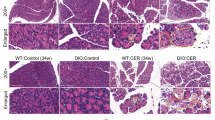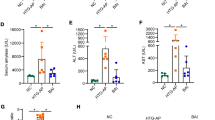Abstract
Objective
In the present study, we investigated the effects of rosiglitazone (10 mg/kg, i.p.), a PPAR-γ agonist, on the development of acute pancreatitis.
Design
Intraperitoneal injection of cerulein in mice induced an acute pancreatitis characterized by edema, neutrophil infiltration elevated serum levels of amylase and lipase. This experimental model was performed to test the anti-inflammatory activity of rosiglitazone.
Setting
University research laboratory.
Interventions
Male CD mice (20–22 g) were allocated into four groups (n=10 for each group): (a) Cerulein+vehicle group. Mice were treated hourly (×5) with cerulein (50 μg/kg, in saline solution, i.p.); (b) Rosiglitazone group (same as the Cerulein+vehicle group but were administered rosiglitazone, 10 mg/kg bolus, 30 min prior to cerulein); (c) Sham+saline group. Mice were treated with saline instead of cerulein; (d) Sham+Rosiglitazone. Identical to Rosiglitazone group except that the saline was administered instead of cerulein. Mice were killed at 6 h after the induction of pancreatitis. Blood samples, pancreas, and lungs were collected.
Measurements and results
Infiltration of pancreatic and lung tissue with neutrophils was associated with enhanced lipid peroxidation. Immunohistochemical examination demonstrated a marked increase in immunoreactivity for nitrotyrosine and for ICAM-1 in the pancreas of cerulein-treated mice. In contrast, the degree of (a) pancreatic inflammation and tissue injury, (b) upregulation/formation of ICAM-1 and nitrotyrosine, and (c) neutrophils infiltration was markedly reduced in pancreatic tissue obtained from rosiglitazone-treated mice.
Conclusion
These findings support the view that rosiglitazone and other potent PPAR-γ agonists may be useful in the therapy of acute pancreatitis.



Similar content being viewed by others
References
Bradley EL (1993) A clinically based classification system for acute pancreatitis: summary of the international Symposium on Acute Pancreatitis, Atlanta, 11–13 September 1992. Arch Surg 128:586–590
Weiss SJ (1989) Tissue destruction by neutrophils. N Engl J Med 320:365–376
Tsujimoto M, Yokota S, Vilcek J, Weissmann G (1986) Tumor necrosis factor provokes superoxide anion generation from neutrophils. Biochem Biophys Res Commun 137:1094–1100
Dominguez-Munoz JE, Carballo F, Garcia MJ (1993) Monitoring of serum proteinase-antiproteinase balance and systemic inflammatory response in prognostic evaluation of acute pancreatitis: results of a prospective multicenter study. Dig Dis Sci 38:507–513
Kusske AM, Rongione AJ, Reber HA (1996) Cytokines and acute pancreatitis. Gastroenterology 110:639–642
Harris ED Jr (1990) Rheumatoid arthritis: pathophysiology and implication for therapy. N Engl J Med 323:996
Ricote M, Li AC, Willson TM, Kelly J, Glass CK (1998) The peroxisome proliferator activated receptor-gamma is a negative regulator of macrophage activation. Nature 391:79–82
Jiang C, Ting A, Seed B (1998) PPARγ agonists inhibit production of monocyte inflammatory cytokines. Nature 391:82–86
Cuzzocrea S, Mazzon E, Dugo L, Serraino I, Centorrino T, Ciccolo A, Van de Loo FAJ, Britti D, Maio M de, Caputi AP, Thiemermann C (2002) Inducible nitric oxide synthase-deficient mice exhibit resistance to the acute pancreatitis induced by cerulean. Shock 17:416–422
Cuzzocrea S, Mazzon E, Dugo L, Centorrino T, Ciccolo A, McDonald MC, Sarro A de, Caputi AP, Thiemermann C (2002) Absence of endogenous interleukin-6 enhances the inflammatory response during acute pancreatitis induced by cerulein in mice. Cytokine 18:274–285
Youssef J, Badr M (2001) Peroxisome proliferator-activated receptors. From orphanage to fame in decade. Saudi Pharm J 9:1–13
Willis D, Moore AR, Frederick R, Willoughby DA (1996) Heme oxygenase: a novel target for the modulation of the inflammatory response. Nat Med 2:87–90
Masferrer JL, Zweifel BS, Manning PT, Hauser SD, Leahy KM, Smith WG, Isakson PC, Seibert K (1994) Selective inhibition of inducible cyclooxygenase 2 in vivo is antiinflammatory and nonulcerogenic. Proc Natl Acad Sci USA 91:3228–3232
Luthen R, Grendell JH, Haussinger D, Niederau C (1997) Beneficial effects of L-2-oxothiazolidine-4-carboxylate on cerulein pancreatitis in mice. Gastroenterology 112:1681–1691
Guice KS, Miller DE, Oldham KT, Townsend M, Thompson JC (1986) Superoxide dismutase and catalase: a possible role in established pancreatitis. Am J Surg 151:163–169
Fu K, Sarras MP Jr, De Lisle R, Andrews GK (1997) Expression of oxidative stress-responsive genes and cytokine genes during cerulein-induced cute pancreatitis. Am J Physiol 273:G696–G705
Grady T, Liang P, Ernst S, Logsdon D (1997) Chemokine gene expression in rat pancreatic acinar cells is an early event associated with acute pancreatitis. Gastroenterolgy 113:1966–1975
Wertheimer SJ, Myers CL, Wallace RW, Parks TP (1992) Intercellular adhesion molecule-1 gene expression in human endothelial cells. J Biol Chem 267:12030–12035
Hashimoto K, Ethridge RT, Saito H, Rajaraman S, Evers BM (2003) The PPARgamma ligand, 15d-PGJ2, attuenuates the severity of cerulean-induced acute pancreatitis.
Acknowledgements
The authors thank G. Pergolizzi and C. La Spada for their excellent technical assistance during this study, Mrs. C. Cutrona for secretarial assistance, and Miss V. Malvagni for editorial assistance.
Author information
Authors and Affiliations
Corresponding author
Rights and permissions
About this article
Cite this article
Cuzzocrea, S., Pisano, B., Dugo, L. et al. Rosiglitazone, a ligand of the peroxisome proliferator-activated receptor-gamma, reduces acute pancreatitis induced by cerulein. Intensive Care Med 30, 951–956 (2004). https://doi.org/10.1007/s00134-004-2180-1
Received:
Accepted:
Published:
Issue Date:
DOI: https://doi.org/10.1007/s00134-004-2180-1




